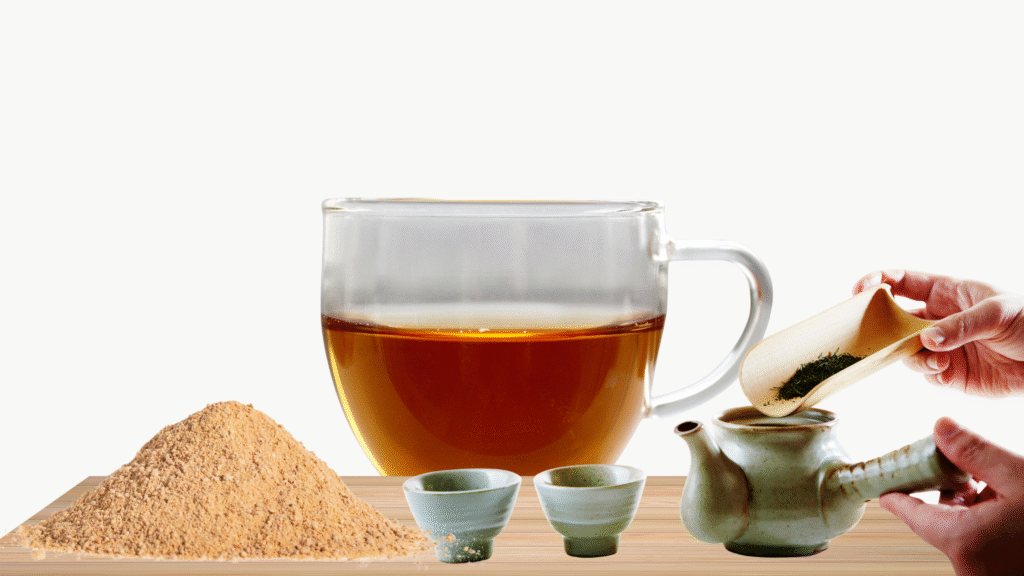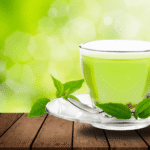How to Brew Sencha Green Tea Perfectly (Step-by-Step Guide)
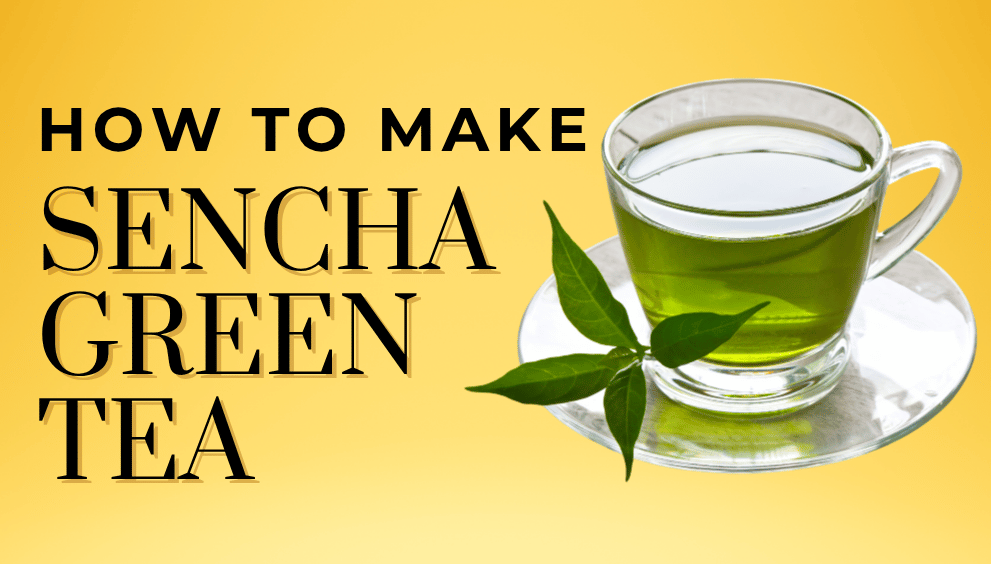
Learn how to brew Sencha green tea at home. Discover the easy steps, ideal temp, and expert tips for U.S. tea lovers to enjoy its full flavour and benefits. Sencha green tea is one of Japan’s most beloved teas for good reason. It has a fresh, grassy aroma and a delicate balance of umami and sweetness. This makes it a favourite among tea lovers in the United States and many countries.
But to enjoy its full potential, brewing it the right way is key. Today’s guide, I’ll share with you the ideal water temperature, steeping time, and expert tips to unlock the best flavour from your Sencha, whether you’re a beginner or a seasoned sipper. Let’s dive into the art of brewing the perfect cup of Sencha Green Tea.
1. Quick Answer: How Do You Brew Sencha Green Tea?
Do you want to brew sencha green tea properly? Use water heated to 160°F–175°F (70°C–80°C) and steep the leaves for 60–90 seconds. Avoid boiling water, as it can make the tea bitter. But for the best flavour and nutrients, always use filtered or soft water, as it’s perfect for your overall health.
Quick Brew Steps:
- Tea leaves: 1 tsp (2g) per cup (6 oz / 180 ml)
- Water temperature: 160–175°F (70–80°C)
- Steep time: 60–90 seconds
- Strain and enjoy immediately; re-steep up to 2 times with slight adjustments
2. What Is Sencha Green Tea?
Sencha is the most popular type of steamed Japanese green tea. It is also known for its fresh, grassy aroma and smooth, umami-rich flavour. Unlike other green teas that may be pan-fired (like many Chinese varieties), sencha is steamed immediately after harvesting, preserving its vivid green colour and antioxidant levels.
Origin & Production
Sencha originates from Japan, where tea leaves are steamed, rolled, and dried, a process that retains the tea’s delicate catechins (antioxidants) and gives it a fresh, vegetal taste. It makes up over 70% of Japan’s tea production.
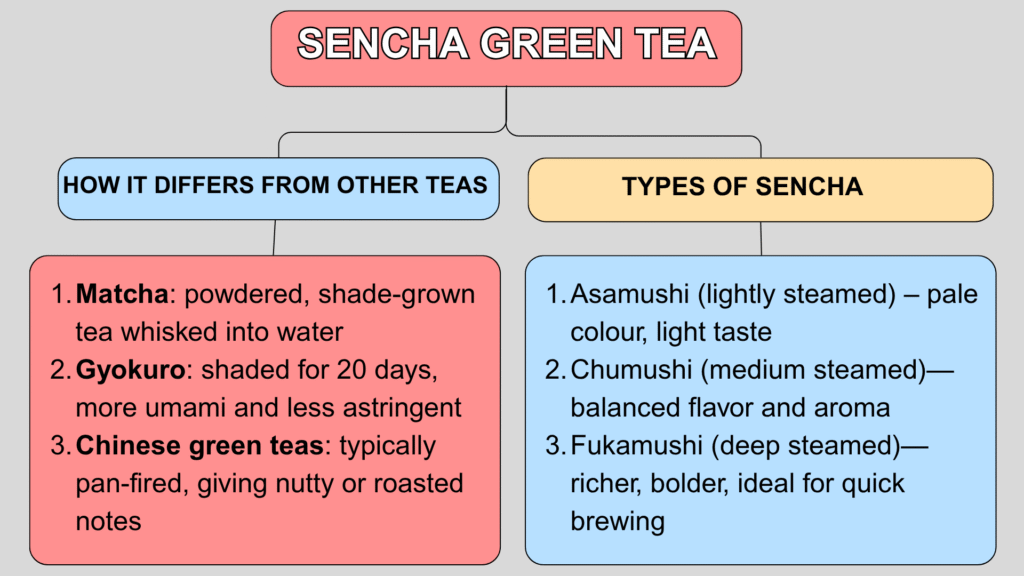
Sencha is perfect for daily wellness routines, offering a smoother and more refreshing cup than most green teas, especially when brewed properly.
3. Why Brew Sencha Correctly?
For a green tea lover, the correct way to brew tea is not just a matter of taste. It’s the key to unlocking its full flavour, aroma, and health benefits. Unlike other drinks, such as black tea or coffee, sencha is heat-sensitive and reacts strongly to the brewing conditions.
1. Avoid Bitterness
Sencha’s leaves contain delicate catechins and amino acids, such as theanine. When water is used too hot (above 175°F / 80°C), it can cause these compounds to break down, leading to a bitter or astringent cup. Proper steeping helps maintain a smooth and balanced flavour.
2. Maximise Flavour
The umami and grassy-sweet notes of sencha come alive at the right temperature and time. Too long or at too high a temperature can overpower these qualities.
3. Preserve Nutrients
Sencha has a high amount of EGCG, vitamin C, and polyphenols. All are sensitive to high heat. Brewing gently ensures that you retain the most antioxidants in your cup, which means more health benefits, such as a better metabolism and immune support.
4. Mindful Tea Practice
The correct method of brewing sencha encourages a moment of mindfulness, helping you slow down, connect with your senses, and support gut health through better digestion.
In short, a carefully brewed tea offers a superior taste, enhanced health benefits, a more enjoyable tea experience, and much more.
4. What You Need to Brew Sencha
The process of brewing sencha green tea is simple, but the right tool makes a big difference in flavour and health benefits.

1. Loose-Leaf Sencha or High-Quality Tea Bags
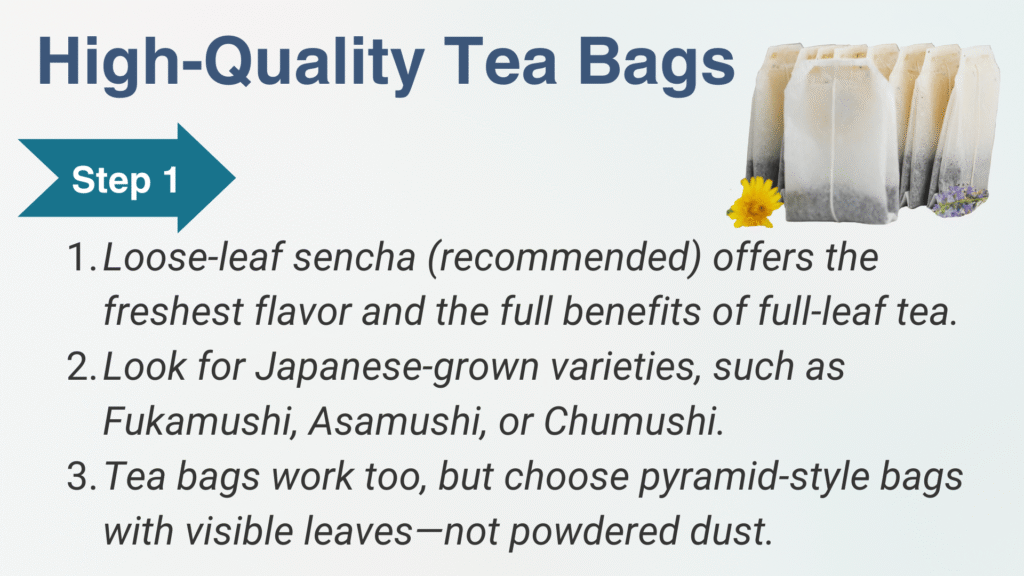
2. Japanese Kyusu Teapot (or Infuser/Teacup)
- A Kyusu (side-handled teapot) is designed for sencha and has a built-in mesh filter.
- If you don’t have one, use a tea infuser ball or a fine mesh strainer with a regular cup.
3. Thermometer or Kettle with Temperature Control
- Sencha is temperature-sensitive. Use water between 160°F–175°F (70°C–80°C).
- A digital thermometer or electric kettle with presets helps you stay accurate.
4. Filtered or Spring Water
- Sencha tastes best with soft water. Avoid hard tap water—it dulls the flavour.
- Use filtered, bottled, or spring water if possible.
Optional Tools: Timer & Digital Scale
- A timer ensures you don’t over-steep (60–90 seconds max).
- A scale helps with consistency (1 tsp or 2g per 6–8 oz cup is ideal).
Quick Tip: Invest in these tools once, and every cup of sencha will be smoother, healthier, and more enjoyable — just like in Japan.
5. Step-by-Step Guide: How to Brew Sencha Green Tea
Brewing sencha the right way enhances flavour, preserves antioxidants like EGCG, and delivers a soothing, mindful experience. Follow these beginner-friendly steps:
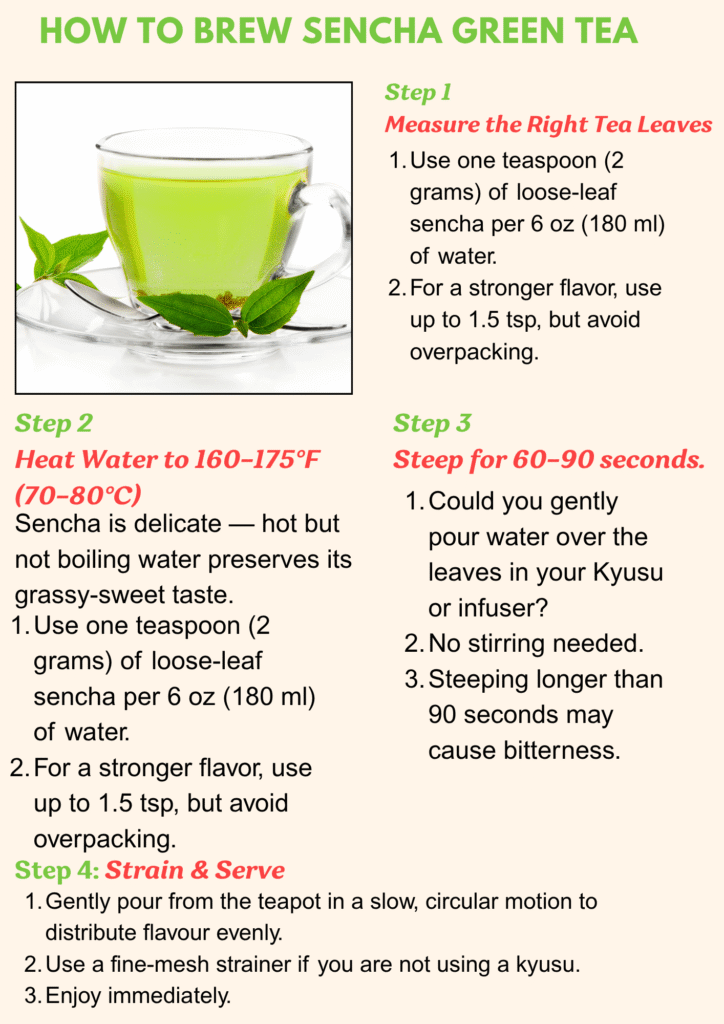
Bonus: Multiple Steeps
Sencha leaves are great for 2–3 infusions:
- 2nd steep: Use slightly hotter water (~175°F) and steep for 30 seconds.
- 3rd steep: Steep for 45 seconds. The flavour will be milder.
Pro Tip: Each steep reveals different layers of flavour — from grassy and vegetal to mellow and sweet. Don’t toss the leaves after one brew!
6. Pro Brewing Tips from Tea Experts
Want to take your Sencha brewing skills to the next level? These expert-backed tips help you extract the most flavour, aroma, and nutrients from every cup — while making the experience more relaxing and rewarding.
Use Soft Water for the Best Taste
- Filtered or spring water brings out Sencha’s authentic, delicate flavour.
- Avoid hard tap water — minerals can dull the taste and colour of your water.
- If using tap water, let it sit for 10–15 minutes or use a charcoal filter.
Warm the Teapot and Cups
- Pour a little hot water into your Kyusu (teapot) and cups before brewing.
- This prevents temperature shock and maintains optimal steeping heat.
- Discard the warm-up water before adding tea leaves.
Master the Second Steep
- Use hotter water (~175°F or 80 °C) for your second infusion.
- Steep for just 30 seconds to extract deeper, rounder flavour notes.
- Many Sencha fans prefer the second steep over the first!
Cold-Brew Sencha for Summer
- Add 1–2 teaspoons of Sencha to 10 oz (300 ml) of cold, filtered water.
- Let it steep in the fridge for 6–8 hours (or overnight).
- Strain and serve over ice — a refreshing, naturally sweet, and low-caffeine beverage.
Expert Tip: Cold-brewed Sencha is higher in L-theanine, an amino acid that promotes calm focus, making it perfect for stress relief and hydration.
7. Best Time to Drink Sencha
It’s my understanding that when you drink Sencha, it can make a significant difference in how you feel and how your body benefits, whether you’re in the USA, UK, or Asia; timing matters.
Morning – Start Fresh with Calm Energy
- Sencha provides a gentle caffeine lift (~20–30mg per cup) — less than coffee, but enough to boost alertness.
- Rich in L-theanine, it promotes a calm focus instead of jitters.
- Ideal for a light start to your day — especially on an empty stomach if tolerated.
Midday – Beat the Slump, Stay Sharp
- A perfect midday reset, Sencha supports mental clarity, digestion, and hydration.
- Helps curb cravings and reduce the urge for sugary snacks or extra caffeine.
- Add lemon or mint for an afternoon refresh in warmer climates, such as California or Florida.
Evening – Use Caution Before Bedtime
- Sencha still contains caffeine — avoid drinking it after 5–6 PM, especially if you’re sensitive.
- It may disrupt deep sleep or REM cycles, especially in women aged 25–45 with busy schedules.
- Opt for decaf herbal teas, such as chamomile or roasted hojicha, if you’re craving tea at night.
Related Post:
Best Time to Drink Green Tea for Weight Loss & Energy
8. Health Benefits of Properly Brewed Sencha
Brewing Sencha green tea the right way isn’t just about taste — it unlocks the full range of health benefits hidden in the delicate leaves. Here’s what science says about why properly prepared Sencha is a powerful daily wellness tool:
1. High in Antioxidants
- Sencha is packed with catechins, especially EGCG (epigallocatechin gallate) — a powerful antioxidant linked to cell protection and anti-ageing.
- Antioxidants combat free radicals, which can help reduce the risk of chronic diseases and promote radiant, healthy-looking skin.
- Proper brewing (160–175°F) preserves these heat-sensitive compounds.
Supports Metabolism & Fat Oxidation
- The combination of EGCG and caffeine naturally boosts metabolism.
- Helps increase fat burning, especially during light exercise or intermittent fasting.
- Widely used in weight loss and detox regimens.
2. May Reduce Inflammation & Lower Blood Pressure
- Regular consumption of Sencha tea may reduce inflammatory markers, according to several studies.
- Contains flavonoids that support cardiovascular health and may help gently lower blood pressure over time.
- Green tea polyphenols have been shown to improve artery flexibility.
3. Supports Digestion & Immune Function
- Sencha’s mild astringency helps stimulate digestion, especially after meals.
- Its antimicrobial properties support gut health and reduce the presence of harmful bacteria.
- Rich in Vitamin C (especially when brewed at lower temperatures), which boosts immune defence.
Pro Tip: Always brew Sencha at a temperature below boiling to preserve its delicate nutrients. A few degrees too hot can destroy these health-promoting compounds.
9. Mistakes to Avoid When Brewing Sencha
A few small mistakes can ruin the flavour and destroy its health benefits. When investing in high-quality Japanese green tea, avoid these common mistakes.
Mistake 1: Using Boiling Water
Why it’s bad: Boiling water (212°F / 100°C) is far too hot for delicate Sencha leaves.
Result: It burns the tea, releasing excessive catechins and tannins, leading to a bitter, harsh taste.
Fix: Always use water cooled to 160°F–175°F (70°C–80°C) for the perfect balance of flavour and nutrients.
Mistake 2: Oversteeping
Why it isn’t good: Leaving the leaves in water too long (over 90 seconds) leads to over-extraction.
Result: You’ll get a muddy, overly grassy taste and risk losing the tea’s fresh, clean character.
Fix: Steep for no more than 60–90 seconds. Use a timer if needed.
Mistake 3: Reheating Brewed Tea
Why it isn’t good: Reheating Sencha after it’s brewed breaks down antioxidants like EGCG and vitamin C.
Result: You lose much of the tea’s nutritional value, and the taste becomes stale or metallic.
Fix: Brew only what you’ll drink fresh. If you want iced tea, brew it properly for cold.
Mistake 4: Using Hard Tap Water
Why it’s bad: Minerals like chlorine, calcium, and magnesium in tap water interfere with flavour extraction.
Result: Your tea may taste dull, chalky, or metallic.
Fix: filtered, soft, or spring water for the best aroma and clarity.
Bonus Tip: Warm your teapot and cup before pouring in the tea. It helps maintain the correct temperature and enhances the aroma.
10. Real User Review: My Sencha Tea Brewing Ritual
1. Amanda from Portland says
I used to brew my green tea just like any other — toss in a bag and pour in boiling water. But Sencha? It’s different. Once I learned to let the water cool to around 170°F and steep it for just over a minute, everything changed. The bitterness vanished, and I finally understood what smooth, slightly sweet green tea was supposed to taste like.
2. Jason from Austin shares his experience.
I cold-brew Sencha overnight during summer and carry it in my insulated bottle. It’s refreshing and energising without making me jittery like coffee.”
In my opinion, Personal stories like these remind us that brewing Sencha isn’t just a task; it’s a mindful experience. Want to share your Sencha ritual? Join our tea-loving community and inspire others!
11. Conclusion
I have proven that brewing Sencha green tea the right way isn’t just about tradition; it’s about unlocking its authentic flavour, maximising its health benefits, and creating a calming daily ritual. With just a little attention to water temperature, steeping time, and quality leaves, you’ll enjoy a delicate, nutrient-rich cup that supports your energy, focus, and well-being.
Now it’s your turn. Try brewing Sencha at home using our step-by-step guide. You’ll be amazed at how much smoother and more satisfying it tastes. And share your experience with tea universes in the comments section.
12. FAQs
Is Sencha stronger than green tea bags?
Yes. Loose-leaf Sencha is typically fresher, more flavorful, and contains higher antioxidant levels than most generic green tea bags.
What does Sencha taste like?
Sencha has a fresh, grassy flavour with umami undertones and slight astringency when brewed properly. Oversteeping or boiling water may make it bitter.
Is Sencha good for weight loss?
Yes. Sencha is rich in catechins, such as EGCG, and contains mild caffeine, which may support fat oxidation and metabolism as part of a healthy lifestyle.
How long should you brew Sencha tea?
Steep Sencha for 60–90 seconds at 160°F–175°F (70°C–80°C) to avoid bitterness and preserve nutrients.
How to brew green tea correctly?
Use filtered water at the correct temperature (never boiling), steep for the recommended time, and avoid oversteeping. This preserves flavour and nutrients. [See Step-by-Step Guide above]
Do you add milk to Sencha tea?
No. Sencha is traditionally consumed plain. Adding milk can alter the taste and reduce the absorption of antioxidants.
What is the difference between green tea and Sencha green tea?
Sencha is a type of Japanese green tea that is steamed after harvesting. It differs from Chinese green teas (which are pan-fired) and has a brighter colour, more pungent aroma, and a unique umami flavour.


